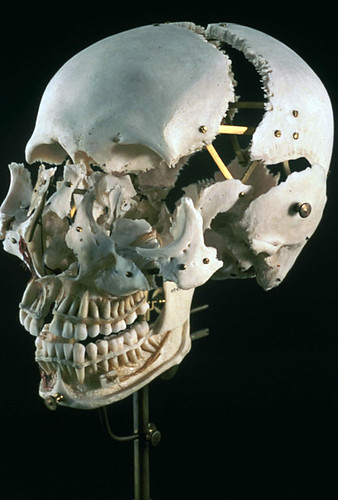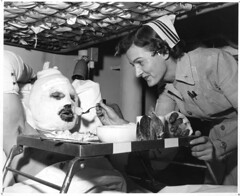Gen. Hosp No. 1
Frederick, Md.
Dec. 11th, 1862
Dear Doctor:
I enclose you my notes of Specimens gathered since Antietam. They amount in all to 187.
I have worked pretty hard over them and I hope you will be satisfied. Many of them are not cleaned off – in some even the soft parts remain – simply from the fact that I did not have the time for so much labor as that would have necessitated. This work could I knew be better done in Washington + as I was anxious to get as full notes as possible I have rather devoted my time and not without result to gathering them.
The specimens are divided into two series 1. Bony + soft specimens 1-165 which occupy the largest part and 2. “Arterial specimens” 1-22 which how ever though mostly are not altogether arterial; but I thought it best not to make too many series for fear of confusion. The former are mostly marked by tins the latter entirely – as I had no readier means – by knotted strings.
Dr. Hewitt has furnished me a large number of specimens and many not in his own name are still from the Hospital under his charge (Gen. Hosp. No 5). He has not been able yet to give me full notes on his own personal cases + by arrangement will therefore send to you direct – numbered to correspond to my list – the histories of the following cases
5 [Danl Hartey. full amp]*
13 [Mo. Welsh. com fract of tarsus]*
14 [Chi Carney. fract of femur lower 30]*
19
20 [M. Dock. fr. of elbow]*
24 [Lewis Wrath. amp shouler joint]*
25 [L. Bard. resection of wrist]*
26 [J. Martin. resec. of wrist]*
27 [Jo. West. resec. of Elbow]*
28 [J. Dennison. resec of __]*
29 [Pamc. Doyle. Resec. of elbow]*
34 [Chs Schaffer. amp left ankle]*
35 [Jim Loaly. amp thight]*
36 [Clark Stillwell. amp of leg]*
40 [M. Floran. resec of condyls of femur]*
61 [H. Hanger. amputation]*
62 [Ian McQueen. amputation]*
63 [M. Henry. amp]*
64 [J. Dibbey. amputation]*
104 [Thos. Nerny. knoyout [?] amputate]*
138 [Alonzo Freeman. arterial S/1 no. 11]*
139 [Lewis Meeker “ “ “ 12]*
142 [J. OBrian. amp of the 3rd of femur]*
143 [Pat Doyle. amp of 3rd of tibia]*
144 [Kennelly. amp of lower 3rd tibia]*
148 [Shay. arterl sh. 17]*
154 [Murphy [?] “ “ 15]*
155 [Geo. Bray. artl 16]*
The rough notes I have of them may be of use in case by any accident he be not able to send his own. As yet (9 Am) I have not got from him the bones of case 155 nor the artery in case 139.
A Cadet of his Mr. Hannen of Hartford Conn. has been very industrious in his work over the specimens. Should you desire any additional aid in preparing those you have in the office for the museum he would be glad to have the work to do and as a sample of what he can do I persuaded him to send you from Hartford a muscular, arterial, + nervous preparation of a boy and also a prepared knee joint. If you like them they may be worth presentation in the museum.
Surg J. B. Lewis U.S.N. Gen. Hospital No. 6 has sent me also 4 very beautiful specimens. He likewise will send you direct the notes of cases nos. 23 [resec of Ho4 humery [?]*, 41 [No. 2 resec of elbow]*, 96 [Amp of Ho4 Tibia No. 3]*, 159 [Reice [?] Ulna no. 4]* numbered to correspond with my list.
Asst. Surg J. H. Bill USA in charge Gen Hosp No. 3 has as yet sent no but one specimen (no. 1). With notes however of several others, the specimens to accompany the notes may however be sent according to promise today + will in that case be enclosed with the others.
From our own G Hospital (Gen. Hosp. No. 1 in charge of R. J. Weir Asst Surg. USA) there are 105 specimens in all. They are credited to the operators whether ante- or past- mortem. The notes in most cases are quite complete and the credit primarily is due for this fact to the exertions of the surgeon in charge who, so far as I am aware, is the only one who has insisted and successfully on keeping up a Hospital Case Book, among all the Hospitals in this place. In this respect as in almost every other regard this Hospital as a model for every one of which I have as yet at least any knowledge.
There have been 4 deaths from Chloroform in Frederick since Antietam. One (as states in the notes to case 102) here one at No. 4 + two at No. 5. I send full notes of our own case - the only one I could obtain – and also notes of a case which was under my observation while at Eckington Hospital D.C. In neither case was any due care lacking. With the case here I send also a specimen of the chloroform used, for examination. Had the means been present, I should have done so myself. The result if it be examined I should like exceedingly to know as I have a copy of the notes. Some of it has also been sent to the maker Squibb in N. Y.
Dr. Weir has the Specimen of a case of wound of the common carotid, in which he performed Synu’s Operation for a traumatic aneurism extending from the jaw to the clavicle + from the sternocleido to the trachea which was pushed one inch to the opposite sides together with the spinal cord with the buckshot in it from the Lance Case both of which he will forward soon; as also the note of an extremely interesting operation for the ligature of the external ihac (approaching it from the inside) for a large traumatic aneurism of the femoral just below Ponpart ligament.
I enclose also (no. 160) the notes on a very curious + I believe rare malformation of the intestines in a case of Typhoid fever which also came under my observation Eckington in May last. The specimens you will find on a shelf over the clothes pegs in 2 bottles in my room at Mrs. Nisbet where I left them when ordered off from Washington.
I enclose also my bills for sundry articles purchased. The amount in all to 11.50. Had I known before I purchased the Bbl + Whiskey I should have written to you to express me one but Dr. Weir informed me you would do so a few days too late. The Whiskey through casting a good deal is the cheapest I could find in town.
Dr. Davis from Birmingham Eng. I have left to take charge of the specimens after I leave tomorrow. He is very enthusiastic in surgery and to such a degree that his object in coming to this country was simply to see the surgery of the War. Until a recent date he has done one full duty on our staff without compensation. He will I think be very efficient + is by far the best man with the best prospect of perseverancey here that I could think of.
In conclusion I think I have learned a great deal even from the very oftentimes cursory examinations I have made of the specimens and if I have satisfied yourself and the Surgeon General in my labors I am amply repaid.
My transfer to West Philadelphia is the most agreeable change possible + the greatest favor I could ask + if you have done aught to aid it let me give you my hearty thanks.-
Very Respectfully
You Obt Svt
Friend + old pupil
W.W. Keen,
Act Asst Surg, USA
[To] John H. Brinton, M.D.
Surgeon U.S.N.
Curator Nat Med Army Museum
Washington, D.C.
*Indicates notes written on the letter, with red pen in a different had, presumably added upon receipt of specimens































